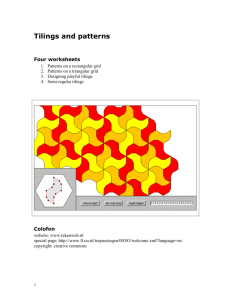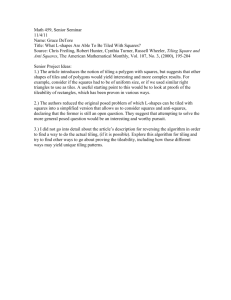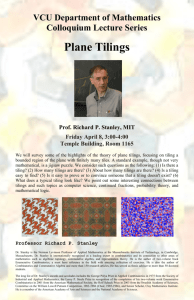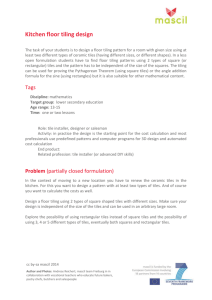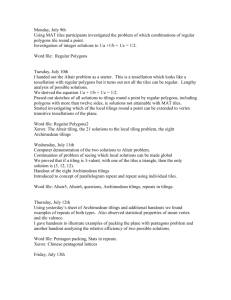TILINGS WITH THE NEIGHBORHOOD PROPERTY Department January State
advertisement
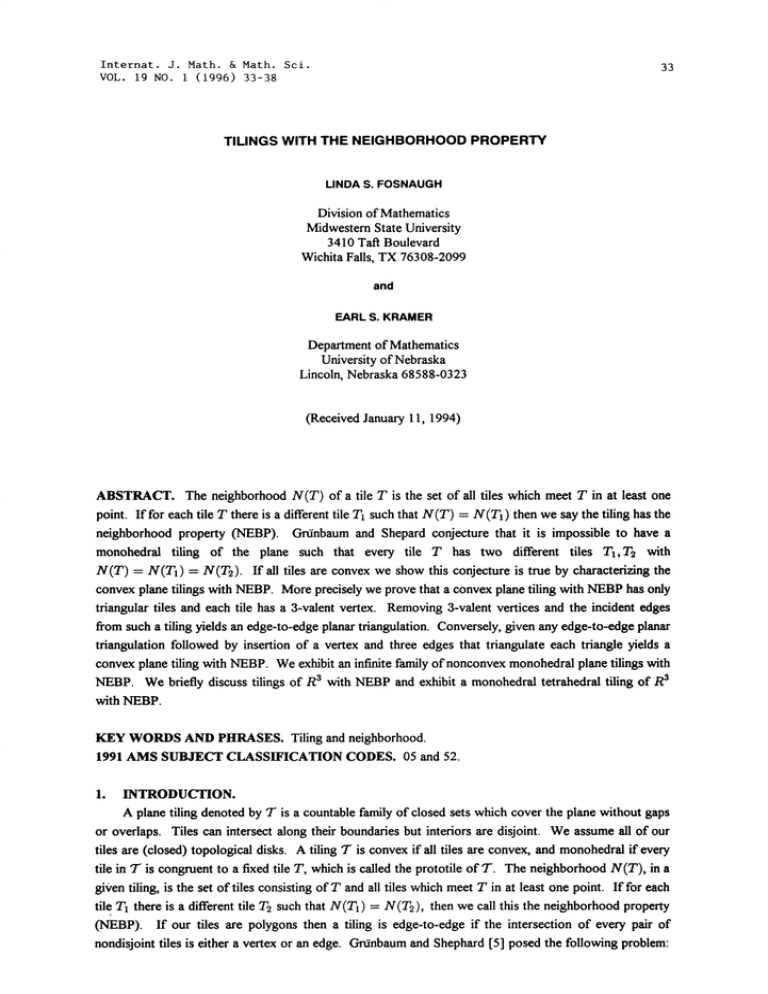
Internat. J. Math. & Math. Sci.
VOL. 19 NO.
(1996) 33-38
33
TILINGS WITH THE NEIGHBORHOOD PROPERTY
LINDA S. FOSNAUGH
Division of Mathematics
Midwestem State University
3410 Taft Boulevard
Wichita Falls, TX 76308-2099
and
EARL S. KRAMER
Department of Mathematics
University ofNebraska
Lincoln, Nebraska 68588-0323
(Received January 11, 1994)
ABSTRACT. The neighborhood N(T) of a tile T is the set of all tiles which meet T in at least one
point. If for each tile T there is a different tile T1 such that N(T) N(T1) then we say the tiling has the
neighborhood property (NEBP). Cm:inbaum and Shepard conjecture that it is impossible to have a
monohedral tiling of the plane such that every tile T has two different tiles TI,T2 with
N(T) N(T) N(T:z). If all tiles are convex we show this conjecture is true by characterizing the
convex plane tilings with NEBP. More precisely we prove that a convex plane tiling with NEBP has only
triangular tiles and each tile has a 3-valent vertex. Removing 3-valent vertices and the incident edges
from such a tiling yields an edge-to-edge planar triangulation. Conversely, given any edge-to-edge planar
triangulation followed by insertion of a vertex and three edges that triangulate each triangle yields a
convex plane tiling with NEBP. We exhibit an infinite family of nonconvex monohedral plane tilings with
NEBP. We briefly discuss tilings of R3 with NEBP and exhibit a monohedral tetrahedral tiling of R3
with NEBP.
KEY WORDS AND PHRASES. Tiling and neighborhood.
1991 AMS SUBJECT CLASSIFICATION CODES. 05 and 52.
INTRODUCTION.
A plane tiling denoted by 7" is a countable family of closed sets which cover the plane without gaps
or overlaps. Tiles can intersect along their boundaries but interiors are disjoint. We assume all of our
tiles are (closed) topological disks. A tiling T is convex if all tiles are convex, and monohedral if every
tile in T is congruent to a fixed tile T, which is called the prototile of 7". The neighborhood N(T), in a
gi,;,en tiling, is the set of tiles consisting of T and all tiles which meet T in at least one point. If for each
tile T1 there is a different tile T2 such that N(T1) N(T2), then we call this the neighborhood property
(NEBP). If our tiles are polygons then a tiling is edge-to-edge if the intersection of every pair of
nondisjoint tiles is either a vertex or an edge. Cm:inbaum and Shephard [5] posed the following problem:
1.
L. S. FOSNAUGH AND E. S. KRAMER
34
Show that there is no monohedral tiling, in which the prototile is a polygonal disk, such that for tile T
there exist two other tiles T and T. such that N(T) N(T
N(T2). We show this is true if the tiles
are convex by characterizing the convex plane tilings with the NEBP.
2. CONVEX PLANE TILINGS.
In R a cone of support to a closed set A at a point p on its boundary is the intersection of all closed
half spaces which contain A and which contain p in their boundary hyperplanes. Let S be a convex set.
A point z in S is called an extreme point of S if there exists no nondegenerate line segment in S that
contains z in its relative interior. The set of extreme points of S is called the profile of S. It is a theorem
that if S is a compact convex subset of R ’, then S is the convex hull of its profile. If 79 is a set of points
then we let cony79 denote the convex hull of 79.
Here we assume that our tiles are convex and (as stated previously) topological disks. Let T and
T2 be different tiles for which N(T) N(T). They clearly meet and since they are convex they can be
separated by a straight line L. We assume that L is oriented to be the z-axis, and T is above the z-axis.
Let # be a point of T1 that is at maximum distance from the z-axis. Such aft exists since T1 is compact.
If a nondegenerate line segment L’ in T1 contained ft in its relative interior or if the supporting cone at ft
were a half-space, then there would be a tile Ts touching T1 at ft where T3 N(T2). Thus the point ft is
an extreme point of T1 and the supporting cone at ft is not a half-space. Let L1 and L2 be two rays
frrming the support cone at ft. It is clear that these two rays L and L 2 must intersect L. Also, the
convexity of our tiles implies that at least three tiles meet at ft.
Suppose Ts and T4 meet T1 at ft and are separated from T1 by lines Ls and /-,4, respectively.
Arguing symmetrically for T, there would be a and a which would meet T2 at an extreme point
It is then elementary to establish that the lines
ft’, and which are separated from T byL and
N
in
and
common
a
Analogously, L, L4, intersect
point P3,
L, L3, intersect
P3 E T1 T f T3 N
in a common point P4, and P4 5 T T N T4 N
Now {p, P4ft} c T, T is convex, and T is bounded by L3, L4, L, hence T1 is the triangle with
vertices ft, P3 and P4. Analogously, T2 is a triangle with vertices ft’, P3 and P4. Clearly T and T’ share an
edge. Suppose another tile T5 met T at ft. Then T5 could meet T only at/93 or P4. But this is dearly
impossible because of the location of T, T4 and the fact that Ts is convex. We have proven:
PROPOSITION 2.1. Let 7" be a convex plane tiling with NEBP. Then the tiles of 7" are triangles.
If T T’ and N(T) N(T’), then T and T’ share an edge. In addition, exactly three tiles meet at
vertex ft(ft’) ofT(T’) which is not on the shared edge.
PROPOSITION 2.2. The tiling is edge-to-edge.
PROOF. Let ea be the edge of T3 and el be the edge of T1 which are both contained in the line Ls
that separates T3 and T. The proof of Proposition 2.1 shows that e C ca. If N(T:;) N(T), then
es e by Proposition 2.1. IfN(Tz) N(T), let T3 play the role of T in Proposition 2.1 to get that
es C e. Thus es el. A symmetric argument shows that the edge of T and that of T4 that lie along
L4 must coincide. The result follows since T is an arbitrary tile.
PROPOSITION 2.3. Let 7" be a convex plane tiling with NEBP. Then each tile (which is a
triangle) has exactly one 3-valent vertex and the other two vertices are at least 6-valent. Further, the
edge opposite the 3-valent vertex in a tile is shared by two tiles whose neighborhoods are equal.
PROOF. By Proposition 2.1 the valency of vertex # in T is 3 and since tiles are convex, the third
vertex of T3, besides P3 and ft, must be at a strictly greater distance from L than ft. Let this vertex be P5
and let the analogous additional vertex of besides P3 and ft’, be p. Note that T3 conv{ft, P3, P5 }
and
conv{ft’, P4, }. But there is no tile with
conv{ft’, P3, }, T4 conv{ft, P4, } and
vertices P3, P, 1 since such a tile would have no vertex of valency three. Hence the valency of P3, and
analogously P4, must be at least 6. The final statement of our result is then immediate.
. .
L.
L
L
:
-
,
I
P
TILINGS WITH THE NEIGHBORHOOD PROPERTY
35
Define a plane triangulatton refinements as follows Begin with any edge-to-edge tiling of the plane
by triangles. Insert a point PT in the interior of each triangle T and draw an edge from PT to each of the
vertices of T. Do this for each of the tiles in the original plane triangulation.
TItEOREM 2.1. A convex plane tiling with NEBP is equivalent to a plane triangulation
refinement.
PROOF. A plane triangulation refinement is easily checked to be a convex plane tiling with NEBP.
Conversely, let T be a convex plane tiling with NEBP. Delete all vertices that are initially 3-valent and
the incident edges. By Proposition 2.3 every tile in 7" is removed by this process. What remains is an
edge-to-edge triangulation of the plane Using the discarded 3-valent vertices as the pr’s gives a
refinement that recreates 7". Our result is clear.
PROPOSITION 2.4. For any fixed positive integer k there is a convex plane tiling with NEBP
using exactly k different tile shapes
PROOF. Begin with an edge-to-edge tiling of the plane with equilateral triangles. For k 1 we
produce a refinement by choosing Pr to be the centroid of each triangle. For k 2 we produce a
refinement by choosing Pr on the line through the centroid and perpendicular to the base of T, but Pr is
not set at the centroid. For k 3 choose PT so three distinct triangles tile T. Clearly, by choosing the
placement of the pr’s we can produce a refinement with any given positive number of k distinct tile
shapes.
3. CONVEX MONOHEDRAL PLANE TILINGS WITH NEBP.
We are now in position to completely characterize the monohedral convex plane tilings with NEBP.
THEOREM 3.1. There is a unique monohedral convex plane tiling 7" with NEBP.
PROOF. We need a simple fact that is easy to verify. Let T be a triangle and let T1, T2 and T3 be
three triangles that tile T edge-to-edge. If T1 is congruent to Tg then T3 is an isosceles triangle. If all
three tiles are equal, then each is the triangle with angles 30 30 and 120 It is now clear that removal
of all 3-valent vertices from 7" along with incident edges produces an edge-to-edge tiling of the plane
with equilateral triangles. Such a tiling is unique, so our tiling T is obviously unique. This tiling is
exhibited in Figure 3.1.
,
.
Figure 3 1.
The automorphism group of a tiling 7- is the set of isometrics that preserve the tiling Such a group
partitions the tiles into transitivity classes where any two tiles within a class can be mapped to each other
via some automorphism. A tiling 7" is isohedral if there is only one transitivity class. The plane isohedral
tilings are completely known (see [3] or [4]) and among the isohedral plane tilings only the tiling of
Figure 3.1 has NEBP. Thus we have:
PROPOSITION 3.1. There is a unique isohedral plane tiling with NEBP
36
L.S. FOSNAUGH AND E. S. KRAMER
Note that Theorem 3.1 and Proposition 3.1 prove the Grnbaum and Shephard conjecture (stated in the
introduction) for plane tilings when the tilings are either convex or isohedral.
4. NONCONVEX PLANE TILINGS WITH NEBP.
One simple example of a nonconvex plane tiling with NEBP is given as follows: With center C on a
straight line L draw circles with varying radii that become arbitrarily large The tiles are the simplyconnected regions. The pair of tiles sharing the same two edges lying along L will have the same
neighborhood.
We now produce monohedral nonconvex plane tiling with NEBP Figure 4 shows how to "dent
in" the edges of each triangle in the tiling of Figure 3.1 so that the tiling is still monohedral.
Figure 4.1.
The following lemma is an easy exercise and the subsequent proposition is immediate.
LEMMA 4.1. If the denting process is applied to Figure 3.1 to produce a monohedral polygonal
nonconvex plane tiling with NEBP, then each tile has an odd number of sides.
PROPOSITION 4.1. For each odd integer k > 3, there is a monohedral plane tiling with NEBP
using tiles with k sides.
One has to wonder here whether all monohedral plane tilings with NEBP arise from Figure 3.1 by a
suitable denting process. From the proof of Proposition 2.4 and the "denting" procedure we have:
THEOREM 4.1. For any fixed positive integer k there is a nonconvex plane tiling with NEBP
using exactly k different tile shapes.
5. SOME TILINGS OF R3 WITH NEBP.
We can extend a tiling of the plane to a tiling of/3 by a natural lifting process (mentioned to us by
B. Cjrnbaum). Let T be a plane tiling (taken to be in the xy-coordinate plane) and d a fixed positive
distance. Define L(’T, d) as follows: for each T in 7", construct a prism with base T and height d. This
produces a slab and now we stack such slabs (face-to-face) to fill/3. Our next result is easy to verify.
PROPOSITION 5.1. Let T be a plane tiling with NEBP. Then L(’T, d) is a tiling of R3 with
NEBP.
From Proposition 4.1 and Proposition 5.1, we immediately have:
COROLLARY 5.1. For each odd positive integer k >_ 5 there is a monohedral tiling of R3 with
NEBP where the tiles have exactly k faces.
We generalize the refinement process described prior to Theorem 2.1. Begin with a face-to-face
tiling "T or R3 using tetrahedral and/or hexahedra with triangular faces. Insert a point Pr in the interior
of each tile T. Clearly T can be subdivided into tetrahedra that are determined by Pr and each face of T.
Do this for each T in 7" to get a refinement of the original face-to-face tiling. The following theorems is
easy to verify:
THEOREM 5.1. The refinement of a face-to-face tiling of R3 using tetrahedra and/or hexadehra
with triangular faces, is a tetrahedral tiling of 3 with NEBP.
TILINGS WITH THE NEIGHBORHOOD PROPERTY
37
A tetrahedron is isosceles if opposite edges are equal. An isosceles tetrahedron clearly has
congruent faces. Also, a tetrahedron is isosceles iff the medians are equal, e., iff the centroid is
equidistant from the vertices of the tetrahedron.
THEOREM 5.2. If there is a monohedral face-to-face tiling of R 3 with isosceles tetrahedra, then
there is a monohedral face-to-face tiling with tetrahedra of R 3 with NEBP.
PROOF. The medians of the isosceles tetrahedra are equal and the faces are congruent. If we
choose PT to be the centroid of a given tetrahedron, then the resulting tetrahedra in the refinement will be
congruent. Our result follows by Theorem 5.1.
The isosceles tetrahedron To with side lengths 2, 2, V/’, V/-, v/’, and v/, tiles E3 face-to-face
(see [2]). In Figure 5.1 three copies ofT0 are shown to tile
Figure 5.1.
a prism. This prism can easily be stacked and translated to produce a face-to-face tiling of Rs using To.
Using Theorem 5.2 the following is then clear:
COROLLARY 5.2. There is a monohedral tetrahedral tiling of Rs with NEBP.
FINAL REMARKS.
One question posed earlier is whether all monohedral plane tilings with NEBP arise from Figure 3.1
by a suitable denting process. Another natural question is whether there is a succinct characterization of
convex tilings of R3 with NEBP as there was for convex plane tilings with NEBP.
6.
ACKNOWLEDGEMENT.
The authors acknowledge Elisabeth Arnold who helped generalize
Theorem 5.1.
1.
2.
3.
4.
5.
6.
7.
REFERENCES
ALTSHILLER-COURT, N., Modern Pure and Solid Geometry, Chelsea Publishing
Company, New York, 1964.
GOLDBERG, M., Three infinite families oftetrahedral space-fillers, J. Comb. Theory A16
(1974), 348-354.
GOLDBERG, M., On the space-filling hexahedra, Geometriae Dedicata 6 (1977), 99-108.
GRtJNBAUM, B. and SHEPHARD, G.C., Isohedral tilings of the plane by polygons,
Comment. Math. Helvet. 53 (1978), 542-571.
GRI3NBAUM, B. and SHEPHARD, G.C., Tilings and Patterns, W.H. Freeman and
Company, New York, 1987.
LAY, S., Convex Sets and Their Applications, John Wiley and Sons, New York, 1982.
SENEcHAL, M., Which tetrahedra fill space?, Mathematics Magazine 54 (1981), 227-243.

